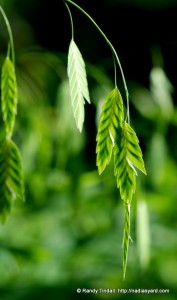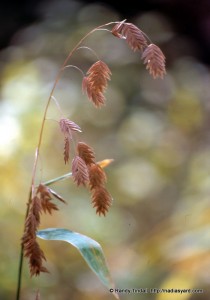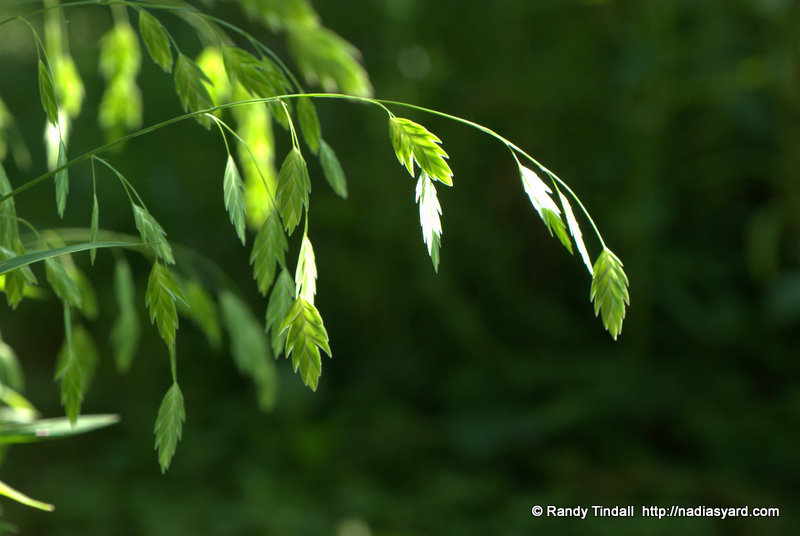River Oats is a handsome native cool-season grass, named for its oat-like seed-heads and fondness for river and stream banks, where it can aid in bank stabilization. It’s relative, Sea Oats (Uniola paniculata), on the east coast and Gulf of Mexico serves the same function for beach dunes. Chasmanthium latifolium (previously known as Uniola latifolia) also goes by the names Wild Oats, Spangle Grass (I like this one), Flathead Oats, Inland Sea Oats, and others.
This grass likes to grow in clumps 2-5 feet tall, although I wouldn’t describe it as a true bunch-grass. The seed-heads are in attractive panicles on gracefully drooping pedicels and change color throughout the season from an early translucent green to a rich brown later in the summer and fall. It is a low-maintenance grass that, in our
yard, tolerates fairly deep shade in healthy clumps, as well as full sunlight, and moist to fairly dry areas. We have not watered it during some very hot and dry periods, and it seems unaffected. It is described as a shade-loving species, but basically seems to be fairly unfussy. In fact, it tends to be so happy that it can become rather rambunctious in its wanderings, and we have manually pulled it out of some areas of our yard where it was getting too ambitious. Pruning the seed-heads before fall can help control its expansion, or if concerned about it getting out of control, plants can be confined to pots. It propagates by seed, plant division and rhizomes.
The seeds are eaten by birds and small mammals, and it is said to attract butterflies, although I can’t say that I have observed many butterflies hanging around it in our yard. Grazers and browsers are said to find it quite palatable. Its usefulness for people, aside from its ornamental qualities, is limited to some use in erosion control and bank stabilization, although one Native American group was said to use its seeds for porridge. It shines in plant arrangements, both dried and fresh. Nadia once used River Oats and other natives to beautifully decorate an old gate from my parents’ farm, which sat in front of our fireplace for two or three years (until we could afford to finally get the fireplace fixed, forcing the gate into retirement).
In short, River Oats are easy to grow and nearly maintenance-free, except for keeping them under control. If that’s a concern, be warned—-they are not voracious, but they are persistent.
Seed is readily available from commercial vendors of native plants seeds, such as Missouri Wildflower Nursery and Hamilton Native Outpost. There are doubtless many others.
Links to C. latifolium information:
http://plants.usda.gov/java/profile?symbol=CHLA5
http://www.mobot.org/gardeninghelp/plantfinder/Plant.asp?code=A240





When do you cut last seasons growth from river Oats?
We don’t have any particular time, but we pretty much never cut anything with seed heads still hanging on it during the winter months. We try to leave as much cover and food for birds as we can. We often get rid of old growth in the spring, when other things are greening up, but if there’s no compelling reason to keep something, we’ll clear it out in the fall.
I am rather fond of this grass. I scattered some seeds of it in a region outside of Philadelphia where I was trying to remove the invasive Japanese stilt grass and replace it with native species, and I was surprised to see a very high germination rate of the seeds. It grows slowly from seed and most of the first-year plants only grew a few inches tall, but I find that the survival rate of seedlings was very good, even among those that were facing some competition from other plants. It also grows thicker and taller than the stiltgrass in the end, which is quite good.
One great thing about this grass is that its tough roots are good at holding soil. If you have a stream through your property, this would be a great plant to plant along the stream.
I also haven’t seen butterflies on this plant, but I think it may be because they only eat it in its larval stage. I’ve read that the butterflies Enodia anthedon, Amblyscirtes vialis, and several other Amblyscirtes sp. feed on this grass in the larval stage. But the flowers are wind-pollinated and don’t produce nectar, so the adult butterflies go elsewhere in source of nectar.
Nice comments, Alex. Thank you. We love this grass in our yard, EXCEPT for the fact that it is somewhat aggressive. I need to control it each year by pulling quite a few plants, because it spreads not only by seed, but through rhizomes. It has many great qualities, some of which you mention. It is also a great addition to dried plant arrangements.
I just bought some of this grass . I wanted to place out in my back yard but after reading this post I am afraid to put it where I wanted to. My back yard leads into some wetland s. Last yr during Irma the area was under about a foot of water. This isn’t an ordinary situation it can more.moist than dry. I can move it closer to the house if I have to. Thanks Mary Ann. (no more Irmas in FL !!!)
I don’t know how river oats will react to very moist conditions, but this grass seems to be very adaptable. Just be aware that it spreads and is very persistent. That said, we have patches around our house and Nadia loves to use it in dried plant arrangements. We pull a lot of it every year to keep it under control and we have reached an agreement with it. Thanks for the comment!
It’s 8/26/22. I’d like to harvest seeds so i can plant them in a new location
When can I pull the seed heads iff the plants?
Thank you